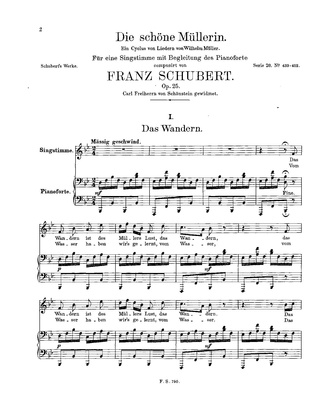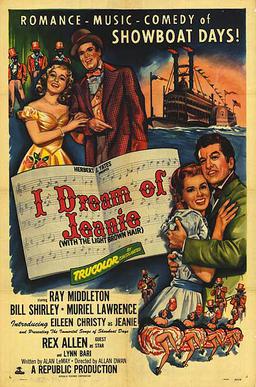Related Research Articles

Die schöne Müllerin, is a song cycle by Franz Schubert from 1823 based on 20 poems by Wilhelm Müller. It is the first of Schubert's two seminal cycles , and a pinnacle of Lied repertoire.

The Times They Are a-Changin' is the third studio album by American singer-songwriter Bob Dylan. It was released on February 10, 1964 through Columbia Records. Whereas his previous albums, Bob Dylan and The Freewheelin' Bob Dylan, combined original material and cover songs, this was the first to feature only original compositions. The album consists mostly of stark, sparsely arranged ballads concerning issues such as racism, poverty, and social change. The title track is one of Dylan's most famous; many feel that it captures the spirit of social and political upheaval that characterized the 1960s.
"I Vow to Thee, My Country" is a British patriotic hymn, created in 1921 when music by Gustav Holst had a poem by Sir Cecil Spring Rice set to it. The music originated as a wordless melody, which Holst later named "Thaxted", taken from the "Jupiter" movement of Holst's 1917 suite The Planets.

My Arms, Your Hearse is the third studio album by Swedish progressive metal band Opeth, released in August 1998. It was the band's first album to be released simultaneously in Europe, through Candlelight Records, and in the United States, through Century Black.

Robert Lucas Pearsall was an English composer mainly of vocal music, including an elaborate setting of "In dulci jubilo" and the richly harmonic part song Lay a garland of 1840, both still often performed today. He spent the last 31 years of his life abroad, at first in Germany, then at a castle he bought in Switzerland.

Once in Royal David's City is a Christmas carol originally written as a poem by Cecil Frances Alexander. The carol was first published in 1848 in her hymnbook Hymns for Little Children. A year later, the English organist Henry Gauntlett discovered the poem and set it to music.
"Streets of Laredo", also known as "The Dying Cowboy", is a famous American cowboy ballad in which a dying ranger tells his story to another cowboy. Members of the Western Writers of America chose it as one of the Top 100 Western songs of all time.
"The Spider and the Fly" is a poem by Mary Howitt (1799–1888), published in 1829. The first line of the poem is "'Will you walk into my parlour?' said the Spider to the Fly." The story tells of a cunning spider who entraps a fly into its web through the use of seduction and manipulation. The poem is a cautionary tale against those who use flattery and charm to disguise their true intentions.

A Ceremony of Carols, Op. 28 is an extended choral composition for Christmas by Benjamin Britten scored for three-part treble chorus, solo voices, and harp. The text, structured in eleven movements, is taken from The English Galaxy of Shorter Poems, edited by Gerald Bullett. It is principally in Middle English, with some Latin and Early Modern English. It was composed in 1942 on Britten's sea voyage from the United States to England.
"Annie Laurie" is an old Scottish song based on a poem said to have been written by William Douglas (1682?–1748) of Dumfriesshire, about his romance with Annie Laurie (1682–1764). The words were modified and the tune was added by Alicia Scott in 1834/5. The song is also known as "Maxwelton Braes".
"The Swimmer" is a poem by the Australian poet Adam Lindsay Gordon. The poem is from his last volume of poems Bush Ballads and Galloping Rhymes published in 1870, when he was living at Melbourne. In The Poems of Adam Lindsay Gordon, it is grouped among "Poems Swinburnian in Form and Pessimism, but full of the Personality of Gordon."
"Peter Quince at the Clavier" is a poem from Wallace Stevens's first book of poetry, Harmonium. The poem was first published in 1915 in the "little magazine" Others: A Magazine of the New Verse, edited by Alfred Kreymborg.

I Dream of Jeanie is a 1952 American historical musical film based on the songs and life of Stephen Foster who wrote the 1854 song "Jeanie with the Light Brown Hair" from which the title is taken. The film was directed by Allan Dwan for Republic Pictures and was shot in Trucolor.
The song "All Around my Hat" is of nineteenth-century English origin. In an early version, dating from the 1820s, a Cockney costermonger vowed to be true to his fiancée, who had been sentenced to seven years' transportation to Australia for theft and to mourn his loss of her by wearing green willow sprigs in his hatband for "a twelve-month and a day", the willow being a traditional symbol of mourning. The song was made famous by Steeleye Span, whose rendition may have been based on a more traditional version sung by John Langstaff, in 1975.
Lumman Tige Srafáin is a poem in DindsenchasÉrann explaining the place legend of Straffan, a town and parish in County Kildare, Republic of Ireland, situated on the banks of the River Liffey 25 km upstream from the Irish capital Dublin, a place about which the author of the poem declares “a happy omen: this spur of land is a prosperous choice.”
Lord Saltoun and Auchanachie, is a Scottish folk song.

Florence Aylward was an English composer known for ballads.

Søvnen, for chorus and orchestra, Opus 18, is Carl Nielsen's second major choral work. It was first performed at the Music Society (Musikforeningen) in Copenhagen on 21 March 1905 under the baton of the composer.
Phyllis E. Zimmerman (1934–2012) was an American composer, choral conductor, and music educator who is accessible on Spotify.

Fifine at the Fair is a poem in Alexandrine couplets by Robert Browning, published in 1872.
References
- 1 2 Madrigals and Partsongs. Oxford University Press. 2001. p. 375. ISBN 0-19-343694-9.
- 1 2 "Lay a Garland". CPDL. 2008-03-31.